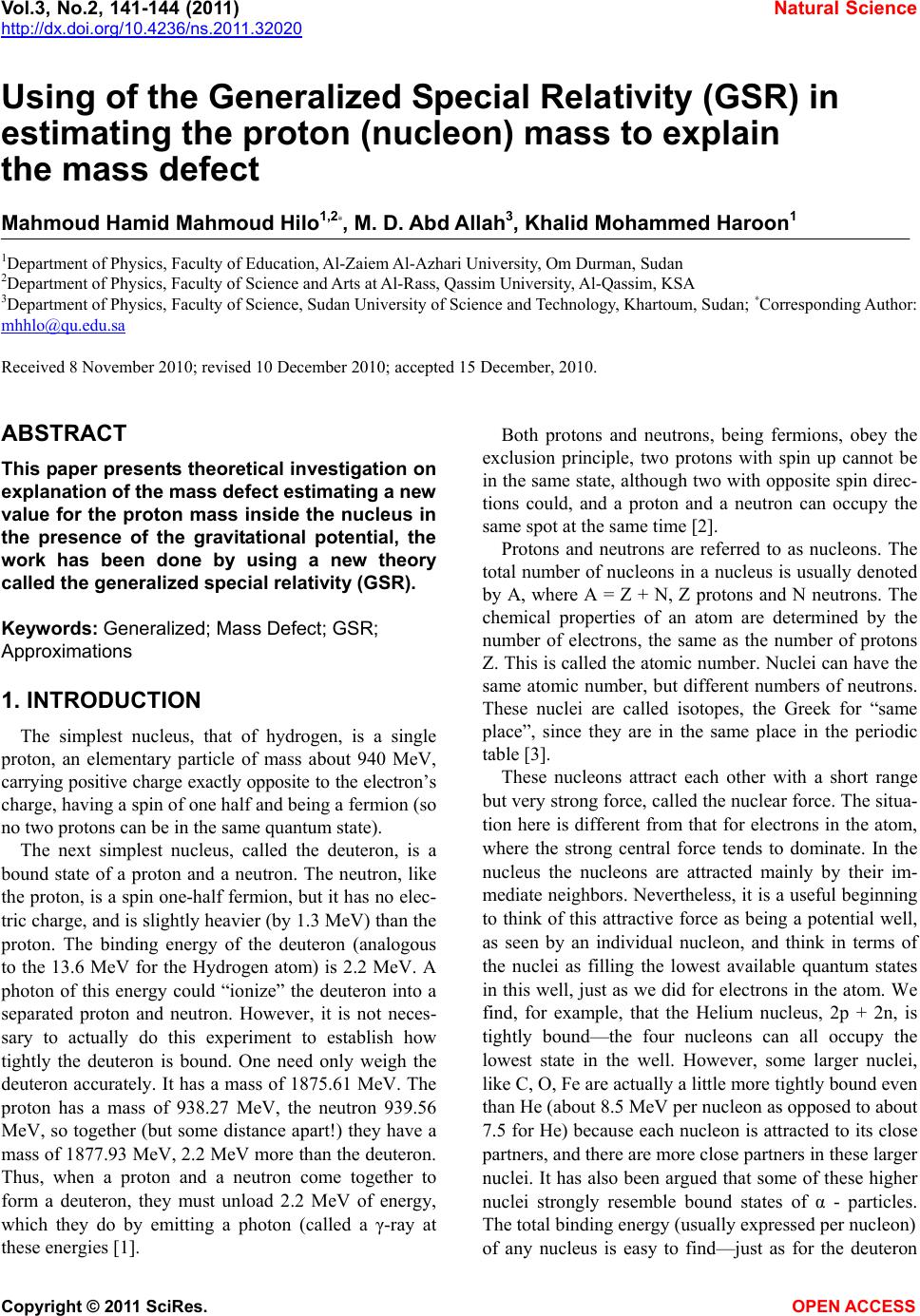
Vol.3, No.2, 141-144 (2011) Natural Science
http://dx.doi.org/10.4236/ns.2011.32020
Copyright © 2011 SciRes. OPEN ACCESS
Using of the Generalized Special Relativity (GSR) in
estimating the proton (nucleon) mass to explain
the mass defect
Mahmoud Hamid Mahmoud Hilo1,2*, M. D. Abd Allah3, Khalid Mohammed Haroon1
1Department of Physics, Faculty of Education, Al-Zaiem Al-Azhari University, Om Durman, Sudan
2Department of Physics, Faculty of Science and Arts at Al-Rass, Qassim University, Al-Qassim, KSA
3Department of Physics, Faculty of Science, Sudan University of Science and Technology, Khartoum, Sudan;
*Corresponding Author:
mhhlo@qu.edu.sa
Received 8 November 2010; revised 10 December 2010; accepted 15 December, 2010.
ABSTRACT
This paper presents theoretical investigation on
explanation of the mass defect estimating a new
value for the proton mass inside the nucleus in
the presence of the gravitational potential, the
work has been done by using a new theory
called the generalized special relativity (GSR).
Keywords: Generalized; Mass Defect; GSR;
Approximations
1. INTRODUCTION
The simplest nucleus, that of hydrogen, is a single
proton, an elementary particle of mass about 940 MeV,
carrying positive charge exactly opposite to the electron’s
charge, having a spin of one half and being a fermion (so
no two protons can be in the same quantum state).
The next simplest nucleus, called the deuteron, is a
bound state of a proton and a neutron. The neutron, like
the proton, is a spin one-half fermion, but it has no elec-
tric charge, and is slightly heavier (by 1.3 MeV) than the
proton. The binding energy of the deuteron (analogous
to the 13.6 MeV for the Hydrogen atom) is 2.2 MeV. A
photon of this energy could “ionize” the deuteron into a
separated proton and neutron. However, it is not neces-
sary to actually do this experiment to establish how
tightly the deuteron is bound. One need only weigh the
deuteron accurately. It has a mass of 1875.61 MeV. The
proton has a mass of 938.27 MeV, the neutron 939.56
MeV, so together (but some distance apart!) they have a
mass of 1877.93 MeV, 2.2 MeV more than the deuteron.
Thus, when a proton and a neutron come together to
form a deuteron, they must unload 2.2 MeV of energy,
which they do by emitting a photon (called a γ-ray at
these energies [1].
Both protons and neutrons, being fermions, obey the
exclusion principle, two protons with spin up cannot be
in the same state, although two with opposite spin direc-
tions could, and a proton and a neutron can occupy the
same spot at the same time [2].
Protons and neutrons are referred to as nucleons. The
total number of nucleons in a nucleus is usually denoted
by A, where A = Z + N, Z protons and N neutrons. The
chemical properties of an atom are determined by the
number of electrons, the same as the number of protons
Z. This is called the atomic number. Nuclei can have the
same atomic number, but different numbers of neutrons.
These nuclei are called isotopes, the Greek for “same
place”, since they are in the same place in the periodic
table [3].
These nucleons attract each other with a short range
but very strong force, called the nuclear force. The situa-
tion here is different from that for electrons in the atom,
where the strong central force tends to dominate. In the
nucleus the nucleons are attracted mainly by their im-
mediate neighbors. Nevertheless, it is a useful beginning
to think of this attractive force as being a potential well,
as seen by an individual nucleon, and think in terms of
the nuclei as filling the lowest available quantum states
in this well, just as we did for electrons in the atom. We
find, for example, that the Helium nucleus, 2p + 2n, is
tightly bound—the four nucleons can all occupy the
lowest state in the well. However, some larger nuclei,
like C, O, Fe are actually a little more tightly bound even
than He (about 8.5 MeV per nucleon as opposed to about
7.5 for He) because each nucleon is attracted to its close
partners, and there are more close partners in these larger
nuclei. It has also been argued that some of these higher
nuclei strongly resemble bound states of α - particles.
The total binding energy (usually expressed per nucleon)
of any nucleus is easy to find—just as for the deuteron